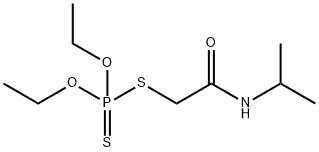PROTHOATE
- CAS NO.:2275-18-5
- Empirical Formula: C9H20NO3PS2
- Molecular Weight: 285.36
- MDL number: MFCD01632787
- EINECS: 218-893-2
- SAFETY DATA SHEET (SDS)
- Update Date: 2024-12-18 14:07:02

What is PROTHOATE?
Chemical properties
White, crystalline solid.Soluble in most organic solvents.
Chemical properties
Prothoate is an amber to yellow crystalline solid with a camphor-like odor.
The Uses of PROTHOATE
Fungicide, ovicide.
Definition
ChEBI: Prothoate is an organic thiophosphate.
General Description
Colorless crystalline solid, with a camphor-like odor. Technical product is an amber to yellow semi-solid. Used as an insecticide and an acaricide.
Reactivity Profile
Organothiophosphates, such as PROTHOATE, are susceptible to formation of highly toxic and flammable phosphine gas in the presence of strong reducing agents such as hydrides. Partial oxidation by oxidizing agents may result in the release of toxic phosphorus oxides.
Hazard
Toxic by ingestion and skin absorption, cholinesterase inhibitor.
Health Hazard
This is a highly toxic material capable of causing death or permanent injury due to exposures during normal use. Small doses at frequent intervals are additive. Similar to parathion.
Fire Hazard
(Non-Specific -- Organophosphorus Pesticide, n.o.s.) Container may explode in heat of fire. Fire and runoff from fire control water may produce irritating or poisonous gases.
Potential Exposure
A potential danger to those involved in the manufacture, formulation and application of the sys- temic acaricide and insecticide.
Shipping
UN2783 Organophosphorus pesticides, solid, toxic, Hazard Class: 6.1; Labels: 6.1-Poisonous materials.
Incompatibilities
Organophosphates are susceptible to for- mation of highly toxic and flammable phosphine gas in the presence of strong reducing agents such as hydrideds and active metals. Partial oxidation by oxidizing agents may result in the release of toxic phosphorus oxides Compounds of the carboxyl group react with all bases, both inorganic and organic (i.e., amines) releasing substantial heat, water and a salt that may be harmful. Incompatible with arsenic compounds (releases hydrogen cyanide gas), diazo compounds, dithiocarbamates, isocyanates, mercap- tans, nitrides, and sulfides (releasing heat, toxic and possi- bly flammable gases), thiosulfates and dithionites (releasing hydrogen sulfate and oxides of sulfur).
Waste Disposal
In accordance with 40CFR165, follow recommendations for the disposal of pesticides and pesticide containers. Must be disposed prop- erly by following package label directions or by contacting your local or federal environmental control agency, or by contacting your regional EPA office.
Properties of PROTHOATE
| Melting point: | 28.5℃ |
| Boiling point: | 152-155℃ (0.1-0.2 Torr) |
| Density | 1.151 g/cm3(Temp: 32 °C) |
| refractive index | 1.5182 (589.3 nm 20℃) |
| pka | 14.12±0.46(Predicted) |
| form | solid |
| Water Solubility | 2.5g/L(20 ºC) |
| CAS DataBase Reference | 2275-18-5 |
| EPA Substance Registry System | Prothoate (2275-18-5) |
Safety information for PROTHOATE
Computed Descriptors for PROTHOATE
New Products
Tert-butyl bis(2-chloroethyl)carbamate 4-Methylphenylacetic acid N-Boc-D-alaninol N-BOC-D/L-ALANINOL N-octanoyl benzotriazole 3-Morpholino-1-(4-nitrophenyl)-5,6-dihydropyridin- 2(1H)-one Furan-2,5-Dicarboxylic Acid DIETHYL AMINOMALONATE HYDROCHLORIDE 1,1’-CARBONYLDIIMIDAZOLE R-2-BENZYLOXY PROPIONIC ACID 1,1’-CARBONYLDI (1,2-4 TRIAZOLE) N-METHYL INDAZOLE-3-CARBOXYLIC ACID (2-Hydroxyphenyl)acetonitrile 4-Bromopyrazole 5-BROMO-2CYANO PYRIDINE 5,6-Dimethoxyindanone 5-broMo-2-chloro-N-cyclopentylpyriMidin-4-aMine 2-(Cyanocyclohexyl)acetic acid 4-methoxy-3,5-dinitropyridine 1-(4-(aminomethyl)benzyl)urea hydrochloride 2-aminopropyl benzoate hydrochloride diethyl 2-(2-((tertbutoxycarbonyl)amino) ethyl)malonate tert-butyl 4- (ureidomethyl)benzylcarbamate Ethyl-2-chloro((4-methoxyphenyl)hydrazono)acetateRelated products of tetrahydrofuran





You may like
-
 2033-24-1 98%View Details
2033-24-1 98%View Details
2033-24-1 -
 1975-50-4 98%View Details
1975-50-4 98%View Details
1975-50-4 -
 2-HYDROXY BENZYL ALCOHOL 98%View Details
2-HYDROXY BENZYL ALCOHOL 98%View Details
90-01-7 -
 2-Chloro-1,3-Bis(Dimethylamino)Trimethinium Hexafluorophosphate 221615-75-4 98%View Details
2-Chloro-1,3-Bis(Dimethylamino)Trimethinium Hexafluorophosphate 221615-75-4 98%View Details
221615-75-4 -
 61397-56-6 CIS BROMO BENZOATE 98%View Details
61397-56-6 CIS BROMO BENZOATE 98%View Details
61397-56-6 -
 14714-50-2 (2-Hydroxyphenyl)acetonitrile 98+View Details
14714-50-2 (2-Hydroxyphenyl)acetonitrile 98+View Details
14714-50-2 -
 118753-70-1 98+View Details
118753-70-1 98+View Details
118753-70-1 -
 733039-20-8 5-broMo-2-chloro-N-cyclopentylpyriMidin-4-aMine 98+View Details
733039-20-8 5-broMo-2-chloro-N-cyclopentylpyriMidin-4-aMine 98+View Details
733039-20-8